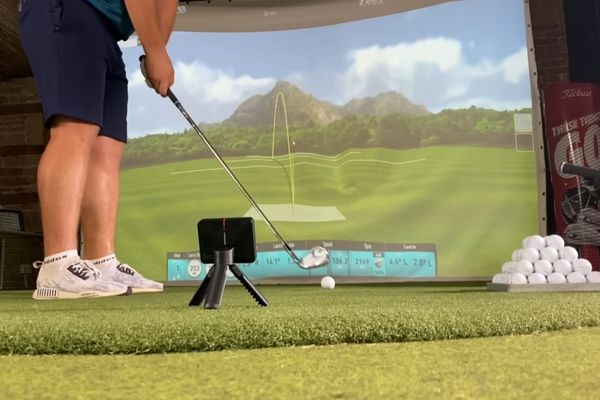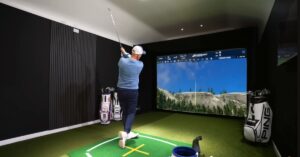What Is A Golf Simulator and How Do They Work? Ultimate Guide to Golf Simulators
Golf simulators are becoming increasingly popular among golf enthusiasts looking to improve their game or simply enjoy the sport year-round.
A golf simulator is an indoor setup that uses advanced technology to replicate the experience of playing golf on a real course.
It typically includes a high-resolution projector or screen, a swing sensor, and software that simulates different courses, weather conditions, and ball flight.
With a golf simulator, you can practice your swing, play virtual rounds, and even compete against other golfers online.
In this blog post, we’ll explore the different types of golf simulators available, the benefits of using one, and how to get started with your simulator setup.
Different Types Of Golf Simulators

Several different golf simulators are available on the market, each with unique features and capabilities. Some of the most popular types include:
#1: Full-swing simulators
These simulators use high-speed cameras and sensors to track the movement of your club and ball, providing a detailed analysis of your swing and ball flight.
They are typically more expensive and require more space, but they offer the most realistic and accurate golfing experience.
#2: Screen-based simulators
These simulators use a high-resolution projector or screen to display a virtual golf course. They typically include a swing sensor and software that tracks your swing and ball flight.
They are more affordable and take up less space than full-swing simulators, but the experience may not be as realistic.
#3: Launch monitors
These devices measure the ball speed, launch angle, spin rate, and other parameters of your shot. They are typically used for practice and analysis and do not provide a full golfing experience.
#4: Indoor putting greens
These simulators focus on replicating the experience of putting on a green. They are not virtual experiences but can be used to practice putting in the comfort of your own home.
#5: Augmented Reality Simulators
This type of simulator combines the use of a projector or screen with a camera and sensors to provide an augmented reality experience. Players will see their shots on the screen as if they were playing on a real course.
#6: Multi-sport simulators
These simulators are designed to be versatile and can be used to play multiple sports, such as golf, baseball, soccer, and more.
They are typically more expensive and take up more space, but they can be a good option for those who want to enjoy a variety of sports in one setup.
#7: Mobile or portable simulators
These simulators are designed to be easily transported and set up in different locations.
They are typically smaller and less expensive than full-swing or screen-based simulators, but they may not offer the same level of realism or accuracy.
#8: Outdoor simulators
These simulators are designed to be used outdoors and typically include a projector or screen and a sensor system. They are less common than indoor simulators and may require additional weather-proofing or protection to maintain their functionality.
#9: Simulation software
This type of simulator is software that can be installed on a computer or mobile device and allows you to play virtual rounds on different golf courses, analyze your swing and practice your game.
Keep in mind that new technology and innovations are constantly emerging in golf simulators so new types may be developed in the future.
Each type of simulator has its strengths and weaknesses, and the best choice for you will depend on your budget, space limitations, and personal preferences.
Benefits of using golf simulators
The use of golf simulators is not limited to professional golfers or those who want to improve their game. It’s also a great way for casual golfers to enjoy the sport in the comfort of their own home, office, or any other place they want.
Golf simulators offer various features that make the experience more realistic, challenging, and fun.
It also allows players to practice different types of shots and play on different courses. There are many benefits to using a golf simulator, including:
Year-round practice: A golf simulator allows you to practice your swing and play virtual rounds of golf even when the weather outside is not suitable for playing on a real course.
Improve your game: Golf simulators provide accurate and detailed analysis of your swing and ball flight, which can help you identify and correct any faults in your technique.
Play on different courses: Most golf simulators come with software that simulates golf courses worldwide. This allows you to play on various courses and experience different terrain and weather conditions.
Play with friends and family: Golf simulators can be a great way to spend time with friends and family, whether you’re playing virtual rounds or competing against each other online.
Cost-effective: A golf simulator can be a cost-effective option for golfers, as it eliminates the need for expensive greens fees or travel costs associated with playing on real courses.
Increase clubhead speed and distance: Golf simulators can help you increase your clubhead speed and distance, allowing you to hit the ball farther and more accurately.
Convenience: Golf simulators are convenient. They can be set up at the home, office, or any other place where you have space, making it easy to practice and play whenever you want.
Safety: Golf simulators offer a safe environment, you can practice your swing without the risk of hitting anyone or anything, and you don’t have to worry about the sun or other weather elements.
Variety: Golf simulators offer a variety of features, such as different golf courses, weather conditions, and shot types. This allows you to have a diverse and challenging experience.
Customizable: Golf simulators can be customized to fit the user’s needs and preferences. This allows you to create a setup tailored to your specific goals and skill level.
How Do the golf simulators work?
Golf simulators are an innovative way to experience the game of golf indoors. Whether you’re looking to improve your swing, practice on virtual golf courses, or play with friends, these high-tech systems use technology to provide an immersive and authentic golfing experience. The following is a step-by-step guide to how a golf simulator works:
Setting up the Simulator Space
The first step in using a golf simulator is to find a suitable space to set it up in. This space should have enough room for the golfer to swing their club comfortably and hit the ball into the screen or projection.
The area should also have good lighting, as the high-speed camera must capture the golfer’s swing clearly.
Utilizing a High-Speed Camera
One of the key components of a golf simulator is the high-speed camera. This camera is placed in front of the golfer and is used to capture their swing movement.
The camera is typically connected to a computer or other device that processes the data and determines the trajectory and distance of the shot.
Hitting into a Virtual Golf Course
After setting up the simulator and positioning the high-speed camera, the golfer will hit a ball into a screen or projection.
This screen will display a virtual golf course and show the golfer where their shot would have landed on a real golf course. This allows the golfer to identify and correct any issues with their swing.
Analyzing Swing Data and Trajectory
After the golfer has hit the ball into the virtual golf course, the computer will use the data captured by the high-speed camera to analyze the swing and determine the trajectory and distance of the shot.
This information can provide feedback to the golfer on their swing, helping them improve their technique.
Utilizing Sensor Technology
Some golf simulators also include sensors on the floor and in the club to track the movement of the golfer’s body and club head.
This can provide more accurate feedback on the swing, allowing the golfer to make more precise adjustments to their technique.
Playing Virtual Rounds of Golf
Many golf simulators also allow multiple players to compete in virtual rounds of golf.
This can be done with various simulated courses to choose from, providing a fun and engaging way to practice and improve one’s golf skills.
Built-in Game Modes and Simulation options
Some Golf simulators also come with built-in game modes such as long-drive competition, closest to the pin, and target practice.
These modes can provide a layer of fun and challenge to the simulator experience, making it even more engaging and enjoyable.
How to Choose the Right Golf Simulator?
When choosing a golf simulator, there are several factors to consider. By considering these factors in detail, you can make a well-informed decision when choosing a golf simulator that meets your needs and fits within your budget.
Space
Measure the space available in your home, garage, or basement, and make sure the simulator will fit comfortably. Some simulators are larger and require more space than others.
Some simulators are designed for indoor use, while others can be used indoors and outdoors.
Make sure you have enough room for the simulator and space for a hitting mat and a screen or projection area.
Budget
Determine how much you are willing to spend and compare different options within that budget.
Golf simulators can range in price from a few hundred dollars to tens of thousands of dollars, depending on the features and accuracy of the simulation.
Be sure to consider not only the initial cost of the simulator but also any ongoing expenses such as maintenance, software updates, and replacement parts.
Simulation accuracy
Check the simulator’s accuracy in terms of ball flight, spin, and launch data. Look for a simulator with high-speed cameras and advanced software to track the ball’s flight accurately and provide realistic feedback on your swing.
Some simulators also include adjustable weather conditions and course variations, making the simulation even more realistic.
Features
Consider which features are important to you, such as multiple course options, online play, and swing analysis.
Some simulators come with many built-in courses, while others require additional courses or subscriptions.
Some simulators include online play, allowing you to compete against other players or connect with a coach for swing analysis and feedback.
Durability
Research the simulator’s build quality, materials, and the company’s reputation in customer service. Look for a simulator built to last and made from durable materials.
It’s also a good idea to check the company’s customer service reputation, as you will likely need assistance with setup and troubleshooting.
Brand
Look at the simulator’s brand and check customer reviews. Research the company’s reputation, customer service, and warranty they offer.
Additionally, look at customer reviews to see what other users have experienced with the simulator and the company.
FAQs
Whether you’re new to golf simulators or have been using one for years, these FAQs will provide helpful information and insights.
What equipment do I need to use for a golf simulator?
You will need a golf club and golf balls to use a golf simulator. Some simulators also require a specific type of sensor or camera to be attached to the club. Check with the manufacturer to see if any additional equipment is required.
Can I use my own golf clubs with a golf simulator?
Yes, you can typically use your golf clubs with a golf simulator. However, you may need to attach a sensor or camera to the club for the simulator to track your swing properly.
How much does a golf simulator cost?
The cost of a golf simulator can vary widely depending on the features and quality of the system. Prices can range from a few thousand dollars for a basic system to tens of thousands for a high-end, commercial-grade simulator.
Are there any downsides to using a golf simulator?
The main downside to using a golf simulator is that it can’t replicate the outdoor experience of playing golf, such as the wind, sun, and rain.
Additionally, some golfers may find the experience of hitting a ball into a screen less satisfying than hitting it on a real course.
Can I play with friends on a golf simulator?
Yes, many golf simulators have multi-player options, so you can play with friends or compete against each other in virtual tournaments.
Can I use a golf simulator to improve my swing?
Yes, many golf simulators include swing analysis software that can help you identify and correct swing faults. This can be a great tool for improving your swing and overall golf game.
Do I need a lot of space to set up a golf simulator?
The amount of space you need for a golf simulator will depend on the specific model and the screen size.
Some systems can be set up in a small room or garage, while others may require a dedicated space, such as a basement or spare room.





![Can A Golf Simulator Improve Your Game? [From Zero to Hero] Can-A-Golf-Simulator-Improve-Your-Game](https://giftedgolfers.com/wp-content/uploads/2023/01/Can-A-Golf-Simulator-Improve-Your-Game-300x157.jpg)
![How Accurate Are Golf Simulators For Distance? [8 Tips To Boost Simulator Experience] How-Accurate-Are-Golf-Simulators-For-Distance](https://giftedgolfers.com/wp-content/uploads/2023/01/How-Accurate-Are-Golf-Simulators-For-Distance-300x157.jpg)